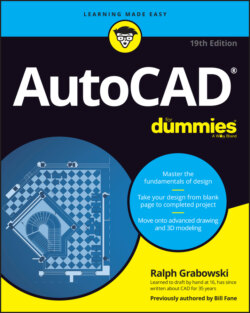Читать книгу AutoCAD For Dummies - Ralph Grabowski - Страница 36
Now that’s a stretch
ОглавлениеThe Stretch command is powerful: It can stretch or move objects, or stretch some and move others at the same time, depending on how you select them. The key to using Stretch is specifying a crossing selection box properly. Chapter 10 gives you more details about crossing selection boxes and how to use them with the Stretch and other editing commands.
Begin with the drawing from the previous section open in AutoCAD, or open the file afd03c-i.dwg contained in the afd03.zip download.
1 On the Modify panel of the Home tab click the Stretch button (shown in the margin).The Stretch command starts, and AutoCAD prompts you to select objects. This is one of those times and one of those command that requires you to watch the command line.
2 Follow the command line instructions to click points from right to left to define a crossing selection box. Select objects to stretch by crossing-window or crossing-polygon…Select objects: Click a point above and to the right of the upper-right corner of the plate (Point 1 in Figure 3-8).Specify opposite corner: Move the cursor down and to the left. Click a point below the plate, roughly under the center of the column (Point 2 in Figure 3-8).The pointer changes to a dashed rectangle enclosing a rectangular green area, which indicates that you’re specifying a crossing selection box. The crossing selection box must cut through the plate and column for the Stretch command to work (see Figure 3-8). You see the following:10 foundSelect objects: Press Enter.FIGURE 3-8: Specifying a crossing selection box for the Stretch command.
3 If these drafting settings aren’t already set this way, turn off Snap (F9) and turn on Ortho (F8) and Object Snap (F3). Then set a base point for the stretch operation. Specify base point or [Displacement] <Displacement>: Move the mouse pointer over the lower-right corner of the plate, and click when you see a square box with an Endpoint tooltip.This point serves as the base point for the stretch operation. (Chapter 11 describes base points and displacements in greater detail.) As before, if you can’t get the cursor to snap to the endpoint, right-click the Object Snap (F3) button and select Endpoint.
4 Specify a displacement for the stretch operation.AutoCAD prompts you at the command line:Specify second point or <use first point as displacement>:Move the cursor horizontally to the right, type 6, and press Enter, as shown in Figure 3-9.AutoCAD stretches the plate and column with its hatching, and moves the anchor bolts by the distance you indicated (see Figure 3-9).FIGURE 3-9: Stretching the base plate.
5 Enter Z A at the command line to see the entire drawing. If the first stretch didn’t work properly, press Ctrl+Z to undo, and then try again. Stretch is an immensely useful command that makes you wonder how drafters used to work with only erasers and pencils.
6 When the stretched drawing is as you want it, press Ctrl+S to save the drawing.
The drawing afd03d-i.dwg contained in the afd03.zip download is the stretched version of the base plate. How does it compare with your version?
After some drawing and editing, you may wonder how you’re supposed to know when to turn off or on the various status bar modes (Snap, Grid, Ortho, Object Snap, and others). Rest assured that you eventually begin to develop an instinctive sense of when they’re useful and when they’re in the way. If a mode is in your way or you realize that you need one, you can click the buttons or press the F keys at any time while using the editing and drawing commands. Later in this book, I give you more-specific guidelines.
